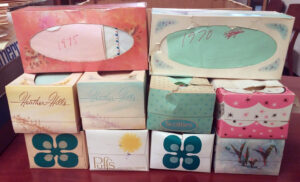As a graduate student in the Archives Specialization in the Department of Information and Library Science, one of my degree requirements is to intern for a semester with a special collections repository. To fulfill this requirement, this fall I have interned at the University Archives where I have primarily focused on processing collections of University records as well as the personal papers of IU faculty and alums.

For the last month, I have been wrestling with a rich and varied collection of correspondence, sound recordings, and manuscripts of the late Toyoyaki Uehara, a longtime member of IU’s Department of East Asian Languages and Culture. Dr. Uehara moved from Japan to Los Angeles, California in 1951 on a scholarship, where he studied, taught, and founded a Tenrikyo church. He began working as an assistant professor at Indiana University Bloomington in 1963 and remained until his retirement in 1990. A respected professor and scholar, a significant portion of the collection consists of correspondence with Uehara’s former students and colleagues in the United States and Japan. Uehara also traveled frequently, and while away, exchanged letters often with his wife, son, brother, and a number of relatives over the decades.

There are ways and ways to maintain and organize correspondence. As a university professor and scholar, knowing that it was possible these materials could be deposited in a repository for preservation and research, it might be assumed that his letters would be organized in some way, perhaps in the same order as they were received, or alphabetically by correspondent. Not in the case of Toyoaki Uehara, or rather, of his wife. Kiyoko Uehara organized and stored her husband’s personal correspondence in a rather unconventional manner – inside tissue boxes. Sometimes, she wrapped the letters in paper and tied them all neatly with Christmas ribbon. Compiled by year (thankfully!), in some instances more than a hundred letters were crammed into these less-than-forgiving cardboard boxes.

A quick overview of the materials shows that it will clearly take some time to open these items and arrange them in folders fit for perusal. As one might imagine, 38 years of exchanges adds up to a fair number of letters, cards, notes, postcards and telegrams. Any item that did not fit easily into the tissue box was likely damaged in some way – bent, torn, or crushed to varying degrees. Delicate airmail and rice paper letters and envelopes that have been deformed and compressed for over 50 years need to be carefully unfolded to avoid tearing or damaging them further (and will eventually make their way to our wonderful paper conservation folks at the Preservation Lab!). It’s going to be a bit of an adventure bringing these missives to light, but it will certainly be interesting discovering what is hiding inside these curious containers.
Leave a Reply